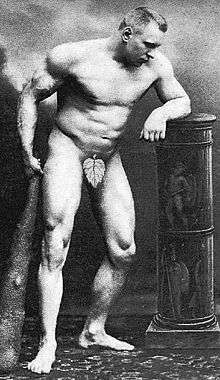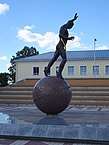Georg Lurich
Georg Lurich (22 April [O.S. 10 April] 1876 – 20 January 1920) was an Estonian Greco-Roman wrestler and strongman of the early 20th century. Lurich was also the trainer of Estonian wrestlers and weightlifters Georg Hackenschmidt and Aleksander Aberg.
| Georg Lurich | |
|---|---|
 Georg Lurich circa 1895 | |
| Born | 22 April 1876 Väike-Maarja, Governorate of Estonia, Russian Empire |
| Died | January 20, 1920 (aged 43) Armavir, Russia |
| Professional wrestling career | |
| Debut | 1895 |
Early life
Born Georg Luri on 22 April 1876 in the village of Väike-Maarja in Viru County, Russian Empire (now Lääne-Viru County, Estonia), he was a son of a shopkeeper named Jüri Luri. Although ethnically Estonian, his family later altered their surname to Lurich after changing religious congregations from a Lutheran Estonian congregation to a predominantly ethnic Baltic German congregation. Lurich's family believed members of the German congregation had better possibilities to educate their children in town schools.[1] Although they changed their surname, Georg suffered physical and mental persecution from mostly Baltic German fellow schoolmates. This situation was the main reason why he began training his body. He studied information about how to train from German-language books.[2] Lurich began participating in sporting activities at an early age.
After graduating from Peter's Modern School in Tallinn (today, Tallinn Secondary School of Science) in 1894, he travelled to St. Petersburg, Russia where he practised weightlifting and wrestling under the supervision of the athletics coach Dr. Władysław Krajewski. Lurich performed in St. Petersburg's summer gardens, competed with local wrestlers and made various lifting demonstrations together with fellow strongman Gustav Boesberg. His popularity convinced him to follow a career in as a professional athlete.[3]
Lurich became the first Estonian to set world weightlifting records. The Estonian public eagerly attended his matches and Lurich's popularity in his homeland soared. From 1897 to 1898 Lurich toured Estonia and his successes helped popularize athletics in Estonia and dozens of athletic clubs were established. In 1896, Lurich befriended an 18-year-old fellow countryman by the name of Georg Hackenschmidt and began to train the young man. Hackenschmidt would later go on to create a name for himself in weightlifting and wrestling.

Travel abroad and death
Prior to World War I, Lurich, along with friend and fellow Estonian wrestler Aleksander Aberg travelled to the United States to perform for American audiences. Lurich performed in free-style wrestling matches in the United States between 1913 and 1917. Lurich wrestled American world wrestling champion and title holder Frank Gotch in Kansas City in 1913, but lost what would be Gotch's final match.[4][5][6]
After returning home via Japan, China and Russia in 1917 they arrived in Estonia in the autumn. They participated in a wrestling tournament in the capital city of Tallinn that remained unfinished due to the approach of German troops. The two athletes went to Saint Petersburg and on to southern Russia. The Russian Civil War meant an end to work in Saint Petersburg and Moscow. Conditions seemed better in the southern region, which was controlled by the White Army. However, the war spread and the men had to flee further inside Russia. They became stranded in a far corner of southern Russia in a village named Armavir. Their initial aim was to leave Russia across the Black Sea by boat.
Things took a dramatic turn in Armavir at the beginning of 1920. The fighting reached them, the town changed hands several times, many civilians perished, and there were many funerals. A warm winter brought about an epidemic of typhoid fever. Due to the war, medical aid was difficult to obtain. Lurich fell ill first and died on 20 January 1920. Aberg had also become infected with typhus, but managed to defeat the illness. However, he rushed his recovery, caught pneumonia, and died on 15 February 1920. The wrestlers were buried in one grave in the Armavir German cemetery.
Legacy
Following Georg Lurich's death on 20 January 1920 at the age of 43, many Estonians began embellishing his accomplishments with such voracity that Lurich's legend began taking on an almost mythological light. Folk tales abounded in rural Estonia and continue to years after Lurich's death. The following excerpt is an example of a Georg Lurich folk tale that has become popular amongst residents of Väike-Maarja, Estonia and was transcribed by Estonian author Kalle Voolaid:
"One hot and sunny summer day Lurich had been sitting on a hill slope in Väike-Maarja and when the heat was becoming too much for him, he ran down into the valley to freshen himself up with cool spring water. While running he hit his foot against a rock and fell on all fours on the stone. Then he stood up, went to the spring, put his feet and hands in the spring and washed with spring water. That is where he got the great strength, he had taken that rock against which he had hit his foot, and played with it as if it were a potato. That rock is said to be still there on the edge of Väike-Maarja memorial hill, covered with moss."
In 1912, Estonian sculptor Amandus Adamson cast a bronze statue of Lurich titled "Champion" which won the 1912 Paris Olympic artist contest.[7] Lurich was also the inspirational model for a plaster of paris sculpture by Adamson titled "Kalevipoeg at the Gates of Hell" (Estonian: "Kalevipoeg põrgu väravas") in 1922.[8][9]
Lurich remains one of the most beloved figures in Estonia to this day. Large tour groups now visit Lurich's memorial stone in Väike-Maarja on Aia Street.
The international Georg Lurich Memorial in Greco-Roman wrestling is held annually in Estonia from 1956.
On 22nd April 2018 Lurich's statue was opened in Väike-Maarja.[10]
Monuments and memorials
 Bas-relief of Lurich at the Tallinn Secondary School of Science
Bas-relief of Lurich at the Tallinn Secondary School of Science Lurich monument created by sculptor Amandus Adamson in the Pirita district of Tallinn
Lurich monument created by sculptor Amandus Adamson in the Pirita district of Tallinn Lurich monument in Väike-Maarja
Lurich monument in Väike-Maarja
References
- S.C. Lurich 02 E.V. Berlin Archived 2009-01-23 at the Wayback Machine
- Lurich by Paavo Kivine (2011) Tallinn: Olympia
- S.C. Lurich 02 E.V. Berlin Archived 2009-01-23 at the Wayback Machine
- http://www.wrestlingsbest.com/collectibles/wrestuffcards017.html
- Gotch Beats Lurich Easily In Only Bout During Year, Chicago Daily Tribune, Dec 28, 1913
- Article by Claude Johnson, sports editor of the Kansas City Star newspaper, April 2, 1913
- Weebly.com
- Amandus Adamson: Looming
- Weebly.com
Further reading
In English:
- The Phenomenon of an Athlete: Georg Lurich from a historical figure to the hero of folk tales by Kalle Voolaid, Estonian Sports Museum.
- Different Aspects Of Understanding Lurich by Kalle Voolaid, published by the Sport-Club Lurich 02 e.V. in Berlin (Scroll down for the essay).
In Estonian:
- Georg Lurich by Olaf Langsepp (1958) Tallinn: Eesti Riiklik Kirjastus.
- Eesti raskejõustiku ajaloost by Georg Kristjanson (1973) Tallinn: Eesti Raamat.
- Lurich Ameerikas by Voldemar Veedam (1981) Toronto: Oma Press Ltd
- Lurich by Paavo Kivine (2011) Tallinn: Olympia
External links
- New York City Wrestling Results - 1915.
- New York City Wrestling Results - 1916.
- "WRESTLER TOFALOS LOSES FIRST BOUT; George Lurich Throws Undefeated Greek Grappler in International Match". New York Times. 1915-11-23. Retrieved 2008-08-08.
- "WRESTLER HURT IN BOUT.; George Lurich Receives Painful Injury in Contest with Zbysko". New York Times. 1915-06-19. Retrieved 2008-08-08.
- John Rauer's "The Web's Best of Amateur Wrestling"
- Georg Lurich at Flickr Commons
- A Walk Through Väike-Maarja
- Classic Bodybuilders
- Sport-Club Lurich 02 e.V. Berlin
- Georg Lurich - The legendary Estonian sportsman and outstanding propagator of physical culture